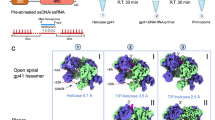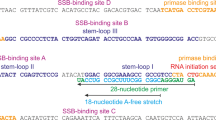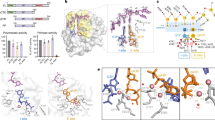Abstract
The unwinding and priming activities of the bacteriophage T4 primosome, which consists of a hexameric helicase (gp41) translocating 5′ to 3′ and an oligomeric primase (gp61) synthesizing primers 5′ to 3′, have been investigated on DNA hairpins manipulated by a magnetic trap. We find that the T4 primosome continuously unwinds the DNA duplex while allowing for primer synthesis through a primosome disassembly mechanism or a new DNA looping mechanism. A fused gp61-gp41 primosome unwinds and primes DNA exclusively via the DNA looping mechanism. Other proteins within the replisome control the partitioning of these two mechanisms by disfavoring primosome disassembly, thereby increasing primase processivity. In contrast to T4, priming in bacteriophage T7 and Escherichia coli involves discrete pausing of the primosome and dissociation of the primase from the helicase, respectively. Thus nature appears to use several strategies to couple the disparate helicase and primase activities within primosomes.
This is a preview of subscription content, access via your institution
Access options
Subscribe to this journal
Receive 12 print issues and online access
$259.00 per year
only $21.58 per issue
Buy this article
- Purchase on Springer Link
- Instant access to full article PDF
Prices may be subject to local taxes which are calculated during checkout






Similar content being viewed by others
References
Benkovic, S.J., Valentine, A.M. & Salinas, F. Replisome-mediated DNA replication. Annu. Rev. Biochem. 70, 181–208 (2001).
Morris, C.F., Sinha, N.K. & Alberts, B.M. Reconstruction of bacteriophage T4 DNA replication apparatus from purified components: rolling circle replication following de novo chain initiation on a single-stranded circular DNA template. Proc. Natl. Acad. Sci. USA 72, 4800–4804 (1975).
Huang, C.C., Hearst, J.E. & Alberts, B.M. Two types of replication proteins increase the rate at which T4 DNA polymerase traverses the helical regions in a single-stranded DNA template. J. Biol. Chem. 256, 4087–4094 (1981).
Kaboord, B.F. & Benkovic, S.J. Accessory proteins function as matchmakers in the assembly of the T4 DNA polymerase holoenzyme. Curr. Biol. 5, 149–157 (1995).
Liu, C.C. & Alberts, B.M. Characterization of the DNA-dependent GTPase activity of T4 gene 41 protein, an essential component of the T4 bacteriophage DNA replication apparatus. J. Biol. Chem. 256, 2813–2820 (1981).
Hinton, D.M. & Nossal, N.G. Bacteriophage T4 DNA primase-helicase. Characterization of oligomer synthesis by T4 61 protein alone and in conjunction with T4 41 protein. J. Biol. Chem. 262, 10873–10878 (1987).
Yang, J., Xi, J., Zhuang, Z. & Benkovic, S.J. The oligomeric T4 primase is the functional form during replication. J. Biol. Chem. 280, 25416–25423 (2005).
Richardson, R.W. & Nossal, N.G. Trypsin cleavage in the COOH terminus of the bacteriophage T4 gene 41 DNA helicase alters the primase-helicase activities of the T4 replication complex in vitro. J. Biol. Chem. 264, 4732–4739 (1989).
Jing, D., Beechem, J.M. & Patton, W.F. The utility of a two-color fluorescence electrophoretic mobility shift assay procedure for the analysis of DNA replication complexes. Electrophoresis 25, 2439–2446 (2004).
Jing, D.H., Dong, F., Latham, G.J. & von Hippel, P.H. Interactions of bacteriophage T4-coded primase (gp61) with the T4 replication helicase (gp41) and DNA in primosome formation. J. Biol. Chem. 274, 27287–27298 (1999).
Zhang, Z. et al. Assembly of the bacteriophage T4 primosome: single-molecule and ensemble studies. Proc. Natl. Acad. Sci. USA 102, 3254–3259 (2005).
Richardson, R.W. & Nossal, N.G. Characterization of the bacteriophage T4 gene 41 DNA helicase. J. Biol. Chem. 264, 4725–4731 (1989).
Cha, T.A. & Alberts, B.M. Effects of the bacteriophage T4 gene 41 and gene 32 proteins on RNA primer synthesis: coupling of leading- and lagging-strand DNA synthesis at a replication fork. Biochemistry 29, 1791–1798 (1990).
Chastain, P.D. II, Makhov, A.M., Nossal, N.G. & Griffith, J. Architecture of the replication complex and DNA loops at the fork generated by the bacteriophage t4 proteins. J. Biol. Chem. 278, 21276–21285 (2003).
Barry, J. & Alberts, B. Purification and characterization of bacteriophage T4 gene 59 protein. A DNA helicase assembly protein involved in DNA replication. J. Biol. Chem. 269, 33049–33062 (1994).
Raney, K.D., Carver, T.E. & Benkovic, S.J. Stoichiometry and DNA unwinding by the bacteriophage T4 41:59 helicase. J. Biol. Chem. 271, 14074–14081 (1996).
Lee, J.B. et al. DNA primase acts as a molecular brake in DNA replication. Nature 439, 621–624 (2006).
Yuzhakov, A., Kelman, Z. & O'Donnell, M. Trading places on DNA–a three-point switch underlies primer handoff from primase to the replicative DNA polymerase. Cell 96, 153–163 (1999).
Trakselis, M.A., Roccasecca, R.M., Yang, J., Valentine, A.M. & Benkovic, S.J. Dissociative properties of the proteins within the bacteriophage T4 replisome. J. Biol. Chem. 278, 49839–49849 (2003).
Nelson, S.W., Kumar, R. & Benkovic, S.J. RNA primer handoff in bacteriophage T4 DNA replication: the role of single-stranded DNA binding protein and polymerase accessory proteins. J. Biol. Chem. 283, 22838–22846 (2008).
Gosse, C. & Croquette, V. Magnetic tweezers: micromanipulation and force measurement at the molecular level. Biophys. J. 82, 3314–3329 (2002).
Lionnet, T., Spiering, M.M., Benkovic, S.J., Bensimon, D. & Croquette, V. Real-time observation of bacteriophage T4 gp41 helicase reveals an unwinding mechanism. Proc. Natl. Acad. Sci. USA 104, 19790–19795 (2007).
Cha, T.A. & Alberts, B.M. Studies of the DNA helicase-RNA primase unit from bacteriophage T4. A trinucleotide sequence on the DNA template starts RNA primer synthesis. J. Biol. Chem. 261, 7001–7010 (1986).
Werner, R. Distribution of growing points in DNA of bacteriophage T4. J. Mol. Biol. 33, 679–692 (1968).
Valentine, A.M., Ishmael, F.T., Shier, V.K. & Benkovic, S.J. A zinc ribbon protein in DNA replication: primer synthesis and macromolecular interactions by the bacteriophage T4 primase. Biochemistry 40, 15074–15085 (2001).
Tanner, N.A. et al. Single-molecule studies of fork dynamics in Escherichia coli DNA replication. Nat. Struct. Mol. Biol. 15, 170–176 (2008).
Yang, J., Nelson, S.W. & Benkovic, S.J. The control mechanism for lagging strand polymerase recycling during bacteriophage T4 DNA replication. Mol. Cell 21, 153–164 (2006).
Khopde, S., Biswas, E.E. & Biswas, S.B. Affinity and sequence specificity of DNA binding and site selection for primer synthesis by Escherichia coli primase. Biochemistry 41, 14820–14830 (2002).
VanLoock, M.S., Chen, Y.J., Yu, X., Patel, S.S. & Egelman, E.H. The primase active site is on the outside of the hexameric bacteriophage T7 gene 4 helicase-primase ring. J. Mol. Biol. 311, 951–956 (2001).
Ishmael, F.T., Alley, S.C. & Benkovic, S.J. Assembly of the bacteriophage T4 helicase: architecture and stoichiometry of the gp41-gp59 complex. J. Biol. Chem. 277, 20555–20562 (2002).
Nossal, N.G. DNA replication with bacteriophage T4 proteins. Purification of the proteins encoded by T4 genes 41, 45, 44, and 62 using a complementation assay. J. Biol. Chem. 254, 6026–6031 (1979).
Acknowledgements
We thank T. Lionnet for initial discussions and D. Bensimon for critical reading of the manuscript. This work was supported by a Human Frontier Science Program grant (to V.C. and S.J.B.), a BioNanoSwitch CEE grant (to V.C.) and US National Institutes of Health grant GM013306 (to S.J.B.).
Author information
Authors and Affiliations
Contributions
M.M. contributed to experimental design, performed single-molecule experiments and wrote the manuscript. M.M.S. contributed to experimental design, prepared the DNA substrates and proteins, performed bulk assays and wrote the manuscript. Z.Z. constructed the fusion protein and performed bulk assays. S.J.B. and V.C. wrote the manuscript, and V.C. built the magnetic tweezers.
Corresponding authors
Supplementary information
Supplementary Text and Figures
Supplementary Figures 1–9 and Supplementary Methods (PDF 1997 kb)
Rights and permissions
About this article
Cite this article
Manosas, M., Spiering, M., Zhuang, Z. et al. Coupling DNA unwinding activity with primer synthesis in the bacteriophage T4 primosome. Nat Chem Biol 5, 904–912 (2009). https://doi.org/10.1038/nchembio.236
Received:
Accepted:
Published:
Issue Date:
DOI: https://doi.org/10.1038/nchembio.236
This article is cited by
-
Correction-free force calibration for magnetic tweezers experiments
Scientific Reports (2018)
-
HTLV-1 Tax plugs and freezes UPF1 helicase leading to nonsense-mediated mRNA decay inhibition
Nature Communications (2018)
-
Human Upf1 is a highly processive RNA helicase and translocase with RNP remodelling activities
Nature Communications (2015)
-
Studying genomic processes at the single-molecule level: introducing the tools and applications
Nature Reviews Genetics (2013)
-
Bacterial replication, transcription and translation: mechanistic insights from single-molecule biochemical studies
Nature Reviews Microbiology (2013)



